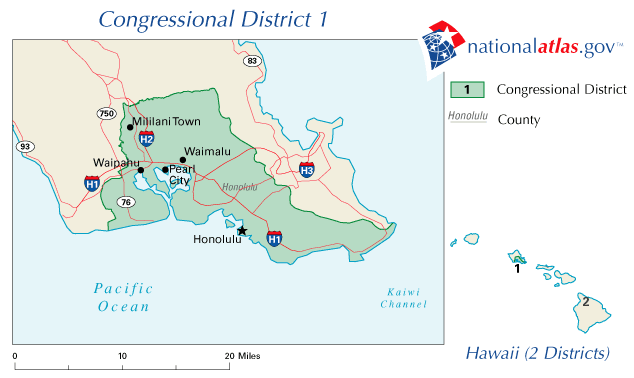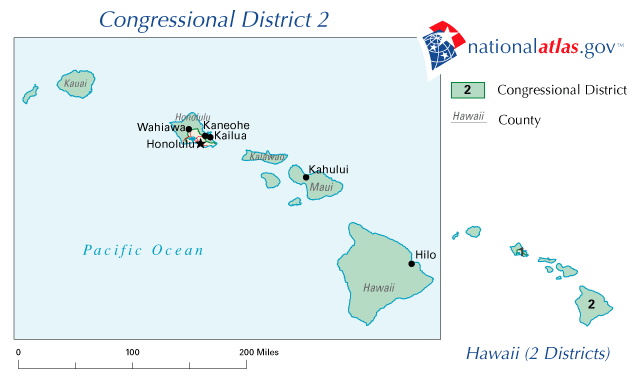- Hawaii's congressional districts
Hawaii has two congressional districts. Before statehood, it was represented by a non-voting delegate.1st district
Infobox U.S. congressional district
state = Hawaii
district number = 1
representative =Neil Abercrombie
party = Democratic
english area =
metric area =
percent urban =
percent rural =
population = 606,718
population year = 2000
median income = 74,905
percent white =18.8
percent black = 2.0
percent asian = 54.3
percent native american = 0.2
percent hispanic = 5.4
percent other race =7.8
percent blue collar =
percent white collar =
percent gray collar =
cpvi = D+7The First Congressional District of Hawaii was officially established in 1971, defined as a result of a
United States Census Bureau report of the previous year indicating an increase in the population of the state ofHawaii .Geography
The district encompasses the urban areas administered by the
City & County of Honolulu , concentrated in the central plains and southern shores of the island ofOahu including the towns of Aiea, Mililani, Pearl City, Waipahu and Waimalu.Demographics
George W. Bush received 47% of the vote in this district in 2004. The district has a Cook Partisan Voting Index score of D +7.History
The residents of the district are represented in the
United States House of Representatives with an elected Congressman. From1963 to the creation of the district, the state of Hawaii was represented in the United States House of Representatives with two Congressmen voted to at-large seats. Previous to1963 , the state of Hawaii had only one seat.Non-residency
Based on laws adopted by the state of Hawaii, a candidate for the First Congressional District of Hawaii does not have to be a resident of the district. The first non-resident to attain the office was Patsy Mink, a resident of rural Honolulu with roots on the island of
Maui . The home office of the First Congressional District of Hawaii is at thePrince Kuhio Federal Building nearHonolulu Harbor .List of representatives
2nd district
Infobox U.S. congressional district
state = Hawaii
district number = 2
representative =Mazie Hirono
party = Democratic
english area =
metric area =
percent urban =
percent rural =
population = 604,819
population year = 2000
median income = 48,686
percent white =29.8
percent black = 1.6
percent asian = 28.8
percent native american = 0.4
percent hispanic = 9.0
percent other race =13.5
percent blue collar =
percent white collar =
percent gray collar =
cpvi = D+10The Second Congressional District of Hawaii is a
congressional district in theU.S. state ofHawaii , officially established in1971 , defined as a result of aUnited States Census Bureau report of the previous year indicating an increase in the population of the state of Hawaii. The district encompasses all rural and most suburban areas administered by theCity & County of Honolulu in the Windward, North Shore, Central and Leeward regions ofOahu as well as areas administered by the County of Kauai, County of Maui and County of Hawaii. The entire district spans 331 miles and comprises small towns with historical roots in thepineapple andsugarcane plantation s.George W. Bush received 44% of the vote in this district in 2004. The district has a Cook Partisan Voting Index score of D +10. From1963 to the creation of the district, the state of Hawaii was represented in the United States House of Representatives with two Congressmen voted to at-large seats. Previous to1963 , the state of Hawaii had only one seat.Based on laws adopted by the state of Hawaii, a candidate for the Second Congressional District of Hawaii does not have to be a resident of the district. The first non-resident to attain the office was
Ed Case , a Honoluluattorney (though Case was born and grew up on the Big Island). The home office of the Second Congressional District of Hawaii is at thePrince Kuhio Federal Building nearHonolulu Harbor .Representatives
Wikimedia Foundation. 2010.
